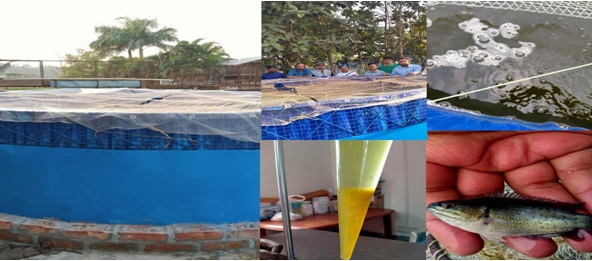Pradipto Biswas
Land-based fish farming, especially with biofloc technology is the best possible way to reduce stress on open water and intensify aquaculture. Recognized as a sustainable and environment friendly technique such “heterotrophic biofloc system” or “active suspension system” stabilizes culture environment and boosts productivity. It holds great scope in the Indian context since it is low cost and can be applied in ponds as well as tanks. This farming system has drawn interest right from poor entrepreneurs to large corporate producers. This is a probiotics assisted technology of farming which take care of increased nutrient assimilation, stimulation of immune system, potential pathogen exclusion, and nitrogen compound degradation in culture water.
What are probiotics?
These are consortia of “live microorganisms which added in adequate quantities to provide benefit actions on host and environment wellness that surrounds them”.
This probiotics assisted biotechnology for last 20 years has increased worldwide in fish and crustacean culture, not only because of their benefit related to gut health in cultured species, but also environmental bioremediation of soil and water in aquaculture systems.
In recent years, bacteria strains which are used in biofloc culture have been expanded, principally Bacillus spp, which are commercialized in preparation form with more live microorganisms, which allow the production of diverse aquatic organisms in aquaculture.
Importance of microbial communities in aquaculture
- Microorganisms constitute an essential part of trophic ecosystems chains, because of their capacity to mineralize nitrogen compounds and clean water ecosystems.
- Contribute with biomass production, which are consumed efficiently by eukaryotes predators and finally to fish.
- Protect from entry of pathogenic microorganisms detection like Aeromonas, Vibrio, Fotobacterium, Enterobacter, among others by poly –?- hydroxybutyrate (PHB) production.
- Biofloc enhance the gene expression of immune related genes such as ProPO1, ProPO2, PPAE, ran, mas and SP1 in shrimps to protect them from the harmful diseases.
- Microbes are of broad physiological diversity in cellulosic, amylolytic, chitinolytic and nitrogen-transforming bacteria and other waste degradation which are generated in culture process of fish and crustacean production.
- Microbes attribute the effects to various mechanisms such as bacterial bioaccumulation, bio assimilation and nitrification.
Biofloc culture system
- Such culture system develops microbial aggregates formed from carbon : nitrogen sources in a proper ratio (C:N-10:1) in water, with low or zero exchange and high oxygenation, diets with low crude protein content and external carbon source like molasses (sugar cane), rice bran, wheat bran, among others.
- The reports show that floc generation is high in the tanks received with low protein in the feed than that of high protein. Floc has well nutritional properties. The dry weight protein ranges from 25 – 50 %, fat ranges 0.5 – 15 %. It is a good source of vitamins and minerals, particularly phosphorous.
- This C: N ratio allows growth of heterotrophic bacteria, which metabolize carbohydrates and consume inorganic nitrogen (principally ammonia NH4 +), reducing their concentration and improve water quality.
- The system is one of the innovative methodologies for waste management and nutrient retention that offers a solution to solve environmental problems in aquaculture because it doesn’t use water exchange to solve nitrogen compound elimination, but it utilizes microbial assimilation, stimulated for addition of material rich in carbon, to transform those compounds. Also, microbial protein can be used as food for culture species.
Nitrogen dynamics in water of biofloc tank (BFT)
- Nitrogen compounds (ammonia and nitrite in particular) are important constraints in aquaculture because they are toxic metabolites for fish and other culture organisms.

- Aquatic organisms excrete mainly non-ionized ammonia (NH3). In water, for most animals that inhabit it, the form of ionized ammonia is not so toxic, while the ammoniacal form is very toxic. The two states of nitrogen related to the excretion of aquatic organisms are known as Total Ammonia Nitrogen (TAN).
- The rate of formation of each molecule (NH3 or NH4 +) depends on pH of the water, so an alkaline pH the NH4 + will be in a lower proportion and the NH3 will be more abundant and in acid pH the first will be the most abundant as-
NH3 + H+ —> NH4 +. Heterotrophic bacteria need to fix 1 gram of ammonia (NH4 +) require about 4.71 g of oxygen (O2), 15.17 g of carbohydrates and generate 8.07 g of suspended volatile solids (SSV).
- The benefits of the dominance of heterotrophic microorganisms in the biofloc have been documented by means of C:N approximate to 20:1 ratios. It has also been reported that there are no totally autotrophic and no totally heterotrophic systems, and there is always a mix between the two types of bacteria.
- In addition to the organic carbon supplementation, application of inorganic carbon in the form of carbonates is indispensable from the beginning of the activity, since the development of the heterotrophic and chemoautotrophic bacteria mainly requires such inputs. Carbonate supplementation is done by providing limes. Alkalizing compounds are capable of providing inorganic carbon to the microorganisms and controlling the pH under conditions of high CO2 production.
- In BFT, three nitrogen conversion pathways occur for the removal of ammonia-heterotrophic bacterial conversion to microbial biomass, autotrophic bacterial conversion from ammonia to nitrate & photoautotrophic removal by algae. In long term the last pathway of conversion becomes most efficient in which two bacterial groups are involved such as ammonia oxidizing bacteria catabolizing unionized ammonia to nitrite (by Nitrosomonas,Nitrosococcus,Nitrosospira etc).Then nitrite oxidizing bacteria (Nitrobacter,Nitrococcus etc.) metabolize nitrite to nitrate.
- Microalgae in BFT such as Chlorophyta, Chrysophyta & Cyanophyta can assimilate ammonia & nitrate to produce biomass and additionally consume carbon dioxide.

Tarpaulin made Biofloc Fish Farming Tank,trainee observing the tank, suspended floc materials, Imhoffcone for measuring floc density & koi fish cultured in the tank
Heterotrophic bacteria (Bacillus subtilis, Bacillus licheniformis, Bacillus coagulans, bacillus megaterium, Bacillus pumilis) but soon with a mix of Nitrobacter and Nitrosomonas are required for floc growth, then assemblage of algae, green algae, diatoms, zooplankton including rotifer nematodes copepods etc also required for floc growth. In greenwater, biofloc algae dominate and in brown water biofloc, bacteria dominate. Floc species show natural growth and succession so the floc quality and water colour shall be monitored and managed regularly.
Following are the list of few microbes used in probiotics in aquaculture.
Bacilllus subtilis- good water quality, growth, immune responses, protection & stress tolerance.
Bacillus cereus –produces higher amounts of polyhydroxybutyrate (PHB) which is one of the main component believed to have role in the energy reserve and growth
Bacillus licheniformis- improves intestinal microflora and its immune ability
Bacillus megaterium- increases the activity of digestive enzymes and the growth of fish
Bacillus coagulans- growth promoter
Bacillus pumilis- larval fish survival and transport stress resistance
B. coagulans SC8168- water quality maintenance
Lactobacillus acidophilus-protective effects against infection
Bifidobacterium-reproduction improvement
Yeast (Saccharomyces) – growth promotion, better digestion, disease protection, reduces intestinal inflammation.
Concluding remarks
Most studies report that there are some benefit with probiotic use, either in growth, immune response or also water quality from cultured species. Likewise, culture with Biofloc have shown better productive yields in fish and crustaceans like shrimp.
Biofloc fish farming offers several exciting potential benefits for farmers.
- More efficient use of land / ability to increase density
- Reduction in feed and antibiotic costs
- Reduction in labour / water-exchange costs
- Improved yields / less disease loss
(Pradipto Biswas is Consultant in Aquaculture , Simurali Krishi Kendra, Dist-Nadia, West Bengal. Views expressed are personal.)





